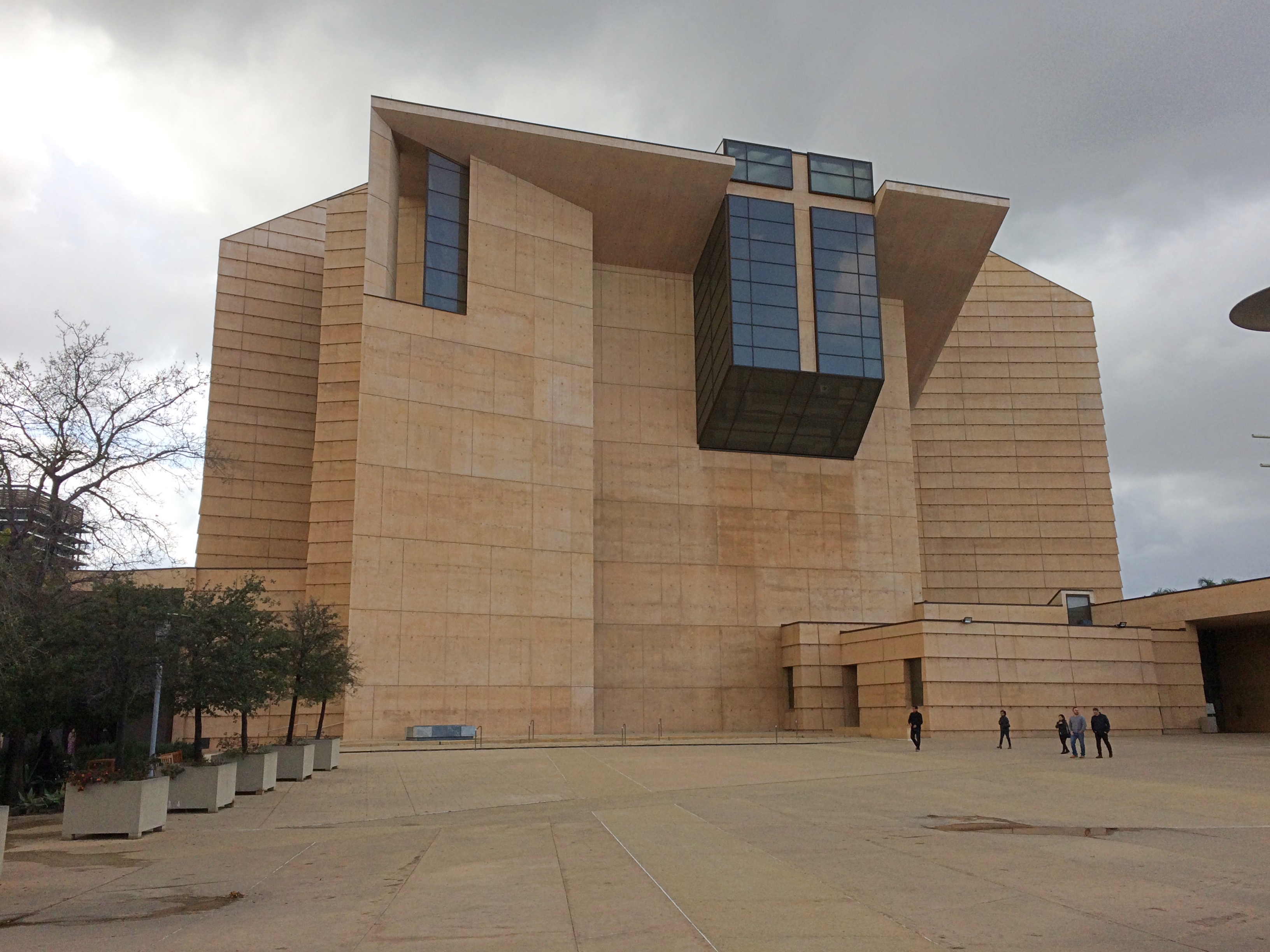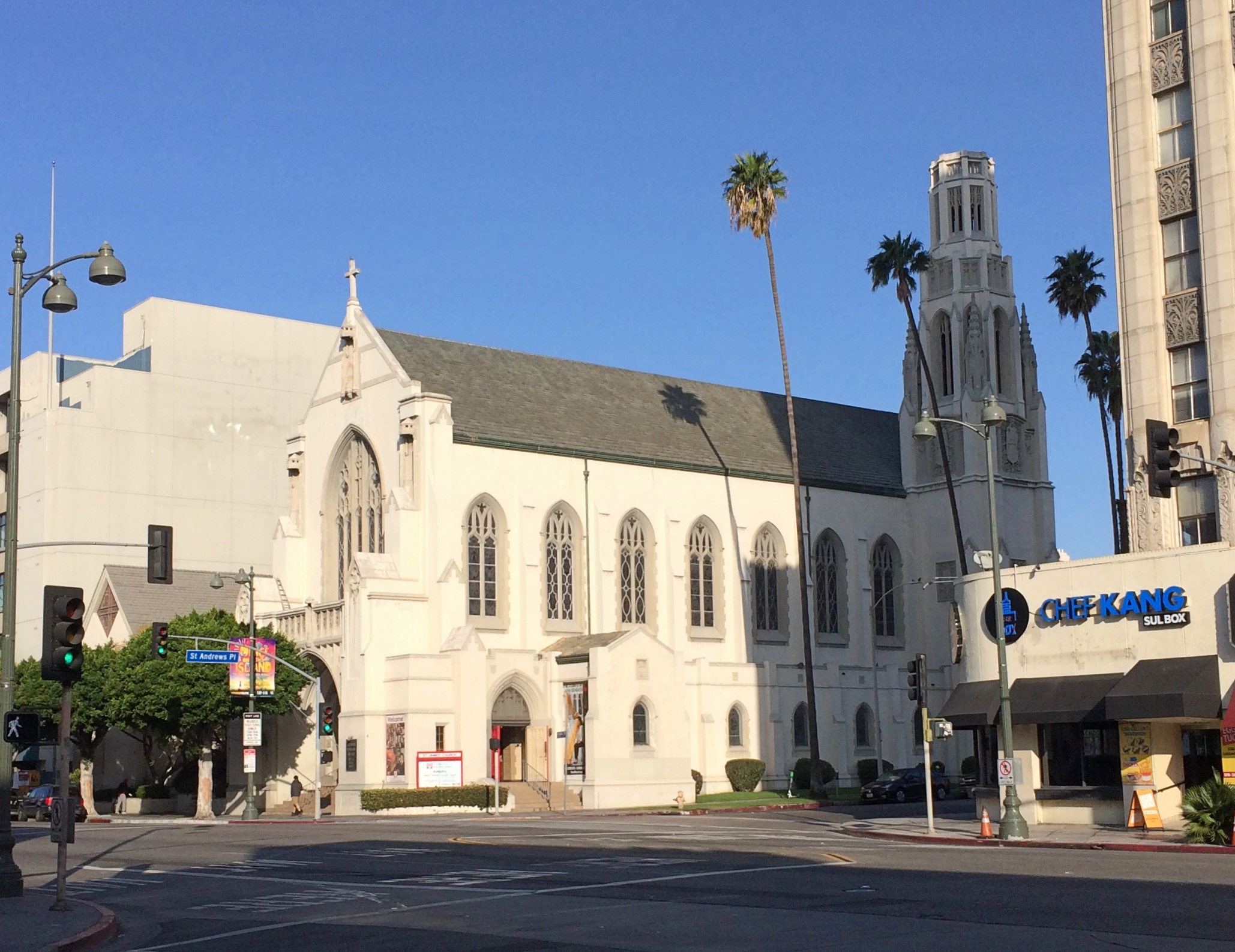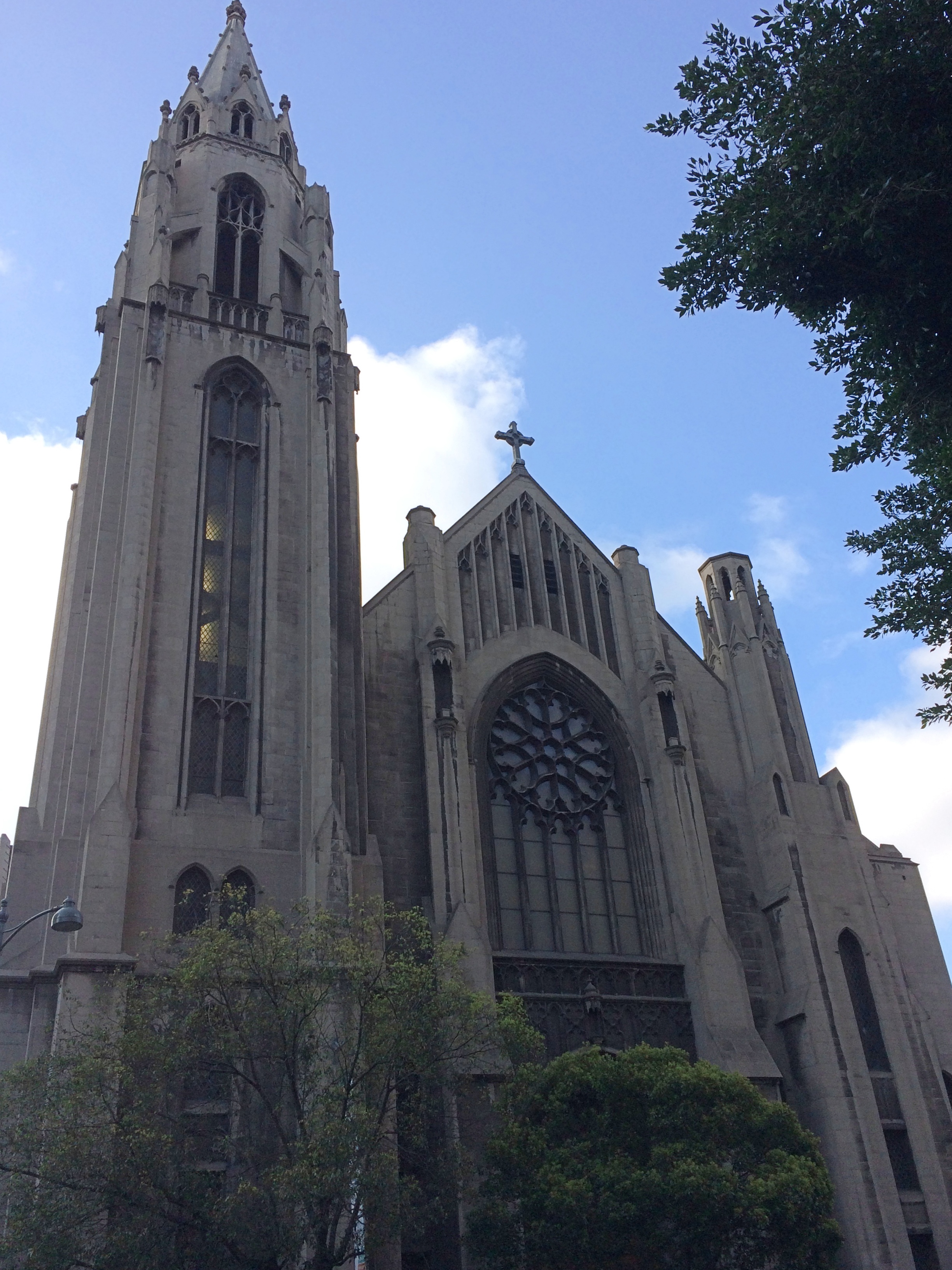Another place that still under construction the last time I visited Los Angeles, in 2001: the Cathedral of Our Lady of the Angels, the seat of the Roman Catholic Archbishop of Los Angeles.
The 1994 Northridge earthquake so badly damaged the previous seat, the 1870s Cathedral of Saint Vibiana, that the archdiocese wanted to tear it down and build another cathedral on the site. Preservationists, led by the Los Angeles Conservancy, fought against that, and so eventually a deal was struck allowing the city to take possession of the former cathedral, and the archdiocese to build a new building on downtown land given to it by the city.
These days the former cathedral is an event center — which I didn’t see — and the new cathedral, completed in 2002, looks like this. Not everyone loves the design by Rafael Moneo, which I’ve seen called deconstructivist or postmodern, but which looks pretty brutal to me. I wasn’t all that fond of it myself, though it is interesting.
Not everyone loves the design by Rafael Moneo, which I’ve seen called deconstructivist or postmodern, but which looks pretty brutal to me. I wasn’t all that fond of it myself, though it is interesting.
Does it say sacred space to me? Not particularly. You could argue that most of us have been conditioned by traditional forms to feel that way. Or you could argue that of course sacred space should be beautiful, not brutal. Take your pick. My goal when I’m somewhere is to see what’s there.
Besides, the interior is less brutal somehow.
 The light fixtures and the natural light help soften the space, I think. Also note that people use the space. While I lurked around the back of the cathedral, a couple named George and Florence were getting married up front. People probably get married there every Saturday except during lent.
The light fixtures and the natural light help soften the space, I think. Also note that people use the space. While I lurked around the back of the cathedral, a couple named George and Florence were getting married up front. People probably get married there every Saturday except during lent.
At the back is the Ezcaray Reredos, an intricate work of carved black walnut.
 It dates from 17th-century Spain. More information about how it came to be in modern California is here, though I will say it left Spain during an impoverished period in the 20th century. The sign in front of the reredos is incorrect, however, when it says that the chapel attached to Saint Philip Neri at Ezcaray, original home of the work, “was dismantled in 1925 after being damaged in the Spanish Civil War…”
It dates from 17th-century Spain. More information about how it came to be in modern California is here, though I will say it left Spain during an impoverished period in the 20th century. The sign in front of the reredos is incorrect, however, when it says that the chapel attached to Saint Philip Neri at Ezcaray, original home of the work, “was dismantled in 1925 after being damaged in the Spanish Civil War…”
On the cathedral’s lower level is a mausoleum.
 Most of the spaces are yet to be occupied. I later read that Gregory Peck is interred there, but I didn’t see him. I did spot California Chief Justice Malcom Millar Lucas (d. 2016), who had the distinction earlier in his judicial career of presiding over the trial of Charles Manson.
Most of the spaces are yet to be occupied. I later read that Gregory Peck is interred there, but I didn’t see him. I did spot California Chief Justice Malcom Millar Lucas (d. 2016), who had the distinction earlier in his judicial career of presiding over the trial of Charles Manson.
The relics of Saint Vibiana are in the mausoleum as well. She was a 3rd-century martyr.
 Atlas Obscura: “Her time in the public eye began in 1853 when her tomb was excavated from the catacombs of San Sisto in Rome. Unlike many of the so-called ‘catacomb saints’ who didn’t even have names, the inscription on Vibiana’s tomb gave her name, the day of her death (August 31), the symbolic laurel wreath of martyrdom, and indicated she was ‘innocent and pure.’
Atlas Obscura: “Her time in the public eye began in 1853 when her tomb was excavated from the catacombs of San Sisto in Rome. Unlike many of the so-called ‘catacomb saints’ who didn’t even have names, the inscription on Vibiana’s tomb gave her name, the day of her death (August 31), the symbolic laurel wreath of martyrdom, and indicated she was ‘innocent and pure.’
“The following year Bl. Pope Pius IX gave her relics — blood, tomb inscription, and body — to Thaddeus Amat, the newly appointed Bishop of Monterrey, California….”
After a time in Santa Barbara, and then many years at the former cathedral in Los Angeles, Vibiana eventually came to where she is now. Interesting that a saint migrated to California like everyone else.
The cathedral isn’t the only church I managed to visit in Los Angeles. Not far away is Our Lady Queen of Angels Catholic Church, an historic parish church.
 I rested a while inside. The name really should be rendered as La Iglesia de Nuestra Señora la Reina de los Ángeles, since all of its masses are in Spanish. The historic marker outside, in English and Spanish, says (in English) that the church “was dedicated on December 8, 1822 during California’s Mexican era. Originally known as La Iglesia de Nuestra Senora de Los Angeles, the church was the only Catholic church for the pueblo. Today it primarily serves the Hispanic population of Los Angeles.”
I rested a while inside. The name really should be rendered as La Iglesia de Nuestra Señora la Reina de los Ángeles, since all of its masses are in Spanish. The historic marker outside, in English and Spanish, says (in English) that the church “was dedicated on December 8, 1822 during California’s Mexican era. Originally known as La Iglesia de Nuestra Senora de Los Angeles, the church was the only Catholic church for the pueblo. Today it primarily serves the Hispanic population of Los Angeles.”
On Sunday morning, as I headed through Koreatown, I spotted St. James’ Episcopal Church, or St. James’ in-the-City, on Wilshire Blvd.
 I attended part of the service that was going on at the time. The church dates from the 1920s, done in a more traditional Gothic Revival by a San Francisco architect, Benjamin McDougall. Most notable about the design: a lot of fine stained glass.
I attended part of the service that was going on at the time. The church dates from the 1920s, done in a more traditional Gothic Revival by a San Francisco architect, Benjamin McDougall. Most notable about the design: a lot of fine stained glass.
Immanuel Presbyterian Church isn’t far away on Wilshire Blvd.

 Unlike St. James’, it wasn’t open when I came by. Still, I got a good look from the across the street.
Unlike St. James’, it wasn’t open when I came by. Still, I got a good look from the across the street.